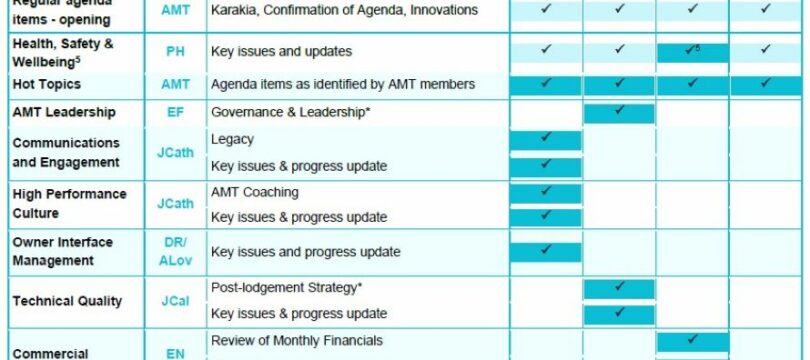
In my last blog The importance of a forward-looking Board on a Project I talked about the importance of the Board of a project being clear on their roles and responsibilities in relation to governing the project effectively through focusing on setting up to be a forward looking board. The blog worked through the development of a forward plan for the Board and how this helps in not only keeping them focused on their role but also allows for effective alignment and discussions with the management team of a project.
This blog explores the setting up of the management team or Alliance Management Team (AMT) in an Alliance operating rhythm. That is, how do they align their operating rhythm to the Board forward plan in a way that ensures key discussions, decisions, issue resolution and other strategic and risk and opportunity discussions are front and centre in driving the project forward? This can be achieved through the development of a monthly meeting operating rhythm or structure that drives outcomes and ensures the management team remains focused on the main game.
For context, it is often challenging for many management team members to understand their roles and responsibilities in managing and leading the Project. The balance between managing the project and leading is challenging in ensuring that we are setting up the project to operate effectively but also effectively leading and looking forward to ensure we are setting up the project team for success. An illustration of an effective balance between being on and in the project as a Management Team is as follows:

Once we are aligned on our balance of being on and in the project we need to establish our management team operating rhythm. To get this management team operating rhythm, you need clear direction and alignment with the Board around the key focus areas for the project which is through the Board forward plan. Once we have this, the management team are able to set up their meeting operating rhythm which needs to cover the following:
- Board meeting dates so that we can work our way back from there to establish the key discussions, paper and agenda items that the management team need to prepare for;
- A clear understanding of agenda items for your management team weekly meetings that either need to be discussed weekly or scheduled on a rotational basis through the month;
- A clear understanding of the Board inputs, papers and alignment topics that require pre-work or discussion to ensure we are ready for the Board meetings;
- An opportunity for key decisions and hot topics to be raised by management team members that accelerate the resolution of them or the ability to engage with the Board to help with issue resolution or additional support; and
- Some flexibility around the meetings in terms of unforeseen matters coming up, hot topics that need to be resolved along with other matters that need to be aligned on.
In terms of what this looks like, I have provided a link to an Alliance Management Team operating rhythm meeting schedule modelled off the Alliance Management Team (AMT) of the Te Tupu Ngātahi Supporting Growth Alliance which has implemented this practice regularly over the lifetime of its Alliance. The link is as follows:
The importance of a management team operating rhythm schedule cannot be overstated in the context of a project running effectively. The Board have a clear understanding through its forward plan of its key focus areas. The management team have aligned their meetings to ensure they deliver on these key focus areas and the wider project team are able to then align through 90 day planning and other initiatives to ensure the ways of working are clearly understood. The sooner this is established, the greater the chance of a project building momentum, making decisions quickly and really driving towards the outcomes their client/s are looking to achieve.



